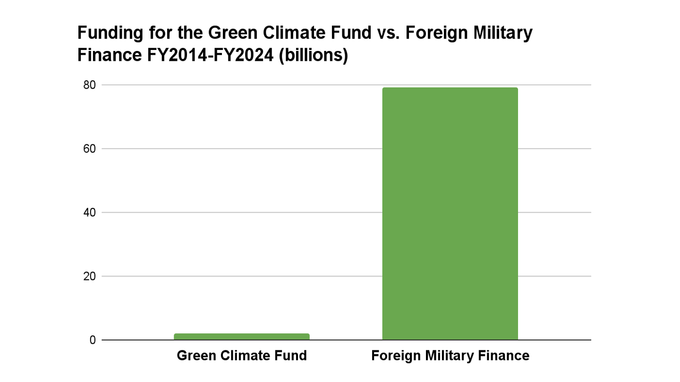The Need to Scale-Up International Climate Finance
The world is rapidly approaching the limits of acceptable warming set by the international community. With emissions on the rise, we are at risk of increasing instability, conflict, and human suffering at a massive scale. Current U.S. investment policies represent business as usual, creating a perfect storm for instability and conflict by funding international weapons sales even as we let climate needs go unmet. To meet the real needs of Global South countries, climate aid must be sufficient in amount, but it also must not exacerbate debt loads for those countries — especially given the fact that they account for just 8% of historical excess emissions. Security demands that we flip the script, investing more in global climate resilience and less in conflict.
The Fight for the Green Climate Fund
The Green Climate Fund (GCF) offers the best existing avenue for channeling public and private funding from the global north to climate action in the Global South.[1] Established by the UN’s climate secretariat, the GCF became operational in 2014 and is the leading mechanism for leveraging public investment in international climate finance to the most climate-vulnerable countries. While a number of multilateral funds exist, the GCF is uniquely effective at administering and mobilizing funds where they are needed most.
Pursuant to U.S. national obligations under the Paris Agreement, President Obama and Biden both included funding for the GCF in their annual overall international climate finance budget requests.
However, Congress has repeatedly zeroed out the GCF budget line in final appropriations bills. Due to this roadblock, the Obama and Biden administrations each redirected $1 billion from the State Department to the GCF, totaling $2 billion in collective U.S. disbursements between 2016-2023. Despite being the world’s largest economy, the U.S. ranks fifth overall in global contributions to the GCF.
U.S. Green Climate Fund Pledges vs. Dispersed Funding
Since 2014, the U.S. has pledged a total of $6 billion to the GCF but has only delivered $2 billion. Congress has never authorized a budget that includes funding for the GCF.
- Obama Administration: The U.S. made its first national GCF pledge of $3 billion under Obama, but only $1 billion was ultimately delivered during his tenure via the State Department’s Economic Support Fund.
- Trump Administration: Trump withdrew the U.S. from the Paris Agreement and withheld requests for the GCF in his federal budgets, fulfilling his campaign promise.
- Biden Administration: In 2021, Biden resigned the Paris Agreement and included a $1.6 billion budget for the GCF in his FY2022 presidential budget request. After funding was blocked by Congress, Biden directed $1 billion in funding from the Economic Support Fund to the GCF. In 2023, Biden pledged the U.S. will deliver an additional $3 billion to the GCF between 2025-2028, though it is unlikely the next Trump administration and Republican-dominated Congress will fulfill this promise.
International Climate Finance vs. Finance for Weapons
Congress has consistently cut budget requests for international climate finance, approving minuscule amounts of funding.[2] In contrast, significant amounts of taxpayer dollars have been funneled into Foreign Military Financing (FMF), or grants the U.S. provides to foreign countries exclusively to purchase U.S.-made weapons.
While funding has lagged behind national pledges on international climate finance (and far short of the real need), members of Congress on both sides of the aisle continue to increase public spending on the Pentagon and police to unprecedented levels:
- The U.S. has the largest military budget in the world, spending more than the next nine countries combined.
- In FY 2023 alone, nearly two-thirds of the federal discretionary budget funded the military-industrial complex and militarized spending, dwarfing public investment in climate action.
- For years 2014-2024, U.S. funding to the GCF totaled $2 billion. In the same period, Congress approved at least $79 billion — 40 times more funding — in FMF to foreign countries to finance the purchase of U.S.-made weapons.[3]

Notes:
[1] Between FY2022-FY2024 Congress also enacted roughly $3 billion in bilateral and multilateral international climate finance, but the GCF remains the best dedicated and most equitable vehicle for international climate finance. Sources: Congressional Research Service ‘U.S. International Climate Finance in Focus’ (factsheets) FY 2023, FY 2024, FY 2025.
[2] Public U.S. international climate assistance is grouped with other forms of international development aid, meaning contributions often have “climate-related” components but tend to support multiple developmental/environmental goals. Most of the entities do not streamline funding to initiatives in climate-vulnerable countries like the GCF, which is exclusively dedicated to climate change and has specific safeguards. There is no standard method for defining or measuring climate finance, consequently reports by donor countries can have discrepancies and result in unclear climate impacts.
[3] FMF data sources: White House Supplemental Budget Materials; Public Budget Database subfunction 152, account codes 1085,1082. The enacted FY2024 FMF total includes $7.1 billion in additional FMF authorized through H.R.815.
LA REVUE GAUCHE - Left Comment: Search results for PERMANENT ARMS ECONOMY

No comments:
Post a Comment